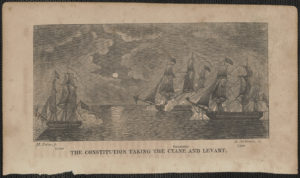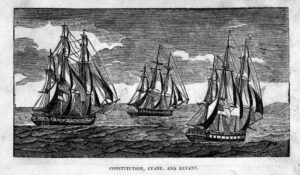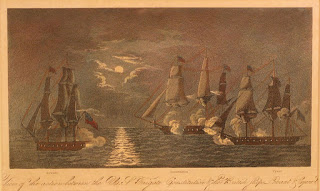Last week, we followed Henry Joslin from his home in Albany, New York though the wilds of the northwest frontier to the intrigue-filled bayous of Louisiana. In the midst of the War of 1812, he was enticed to join the crew of the US Navy’s most famous ship. The story of his eventful life continues:
Captain Henderson, one of the marines came to us and said we had six months pay due us, and if we would go out in the Constitution we should have the six months pay & a run on shore. We volunteered, had our frolic and sailed in “Old iron sides” and cruised all over the world. Fell in with, and passed the English frigate La Peak, it was quite calm1. She under short sail waiting for us to come down. All hands were called to reef topsails by Lieut. Ballard, in so doing we lost the little head way we had, and swung round, and as soon as they saw our broadside, they made sail and stood away as fast as the light air would allow. Before we could shake out the reefs and make sail- She caught the land breeze. It being evening, we lost sight of her, in the haze, and at the same time lost our fortunes, as she was loaded with money and stores for Quebeck.
We cruised round some time, until we ran in off Portsmouth (N.H.) and laid by that night & the following, and as soon as the fog lifted we discovered two English frigates2. They gave chase and drove us into Marblehead, and were blockaded one week, one day they drifted some distance to seaward, and there being a fine breeze Commodore Stewart said “we will show those fellows our heels” but he wanted everything that was done to be done in a croak, so underweigh we got and slipped out. They gave chase, but we got safely into Boston.
Then the English sent three frigates “Leander” 64 “New Castle” 64 and “Castor” 50 to blockade us, and after remaining one week, Comr. Stewart got roused, and told the pilot to take him out at sunset 3. So out we went, landed Captain Knox, our pilot, and as passed Cape Cod at night, we saw the yards and masts of all three over the land, the Tories at Cape Cod, knowing we had broken the blockade, burnt lights to inform the Squadron we had escaped. We had not been long out, before we fell in with a six gun Schooner convoying a ship with a cargo for Canada4. Took from her all we required, and being an American vessel captured formerly by the British Commodore Stewart called all hands, and proposed we should give the vessel to the Captain’s wife. In the meantime, we took from this vessel the signal, & Book. We then made signal, and brought the Schooner down to us_ Her captain came on board, and as soon as he found out the state of the case, said, “this is the Second time I have been captured by this Frigate.” We kept her a day or two and then blew her up about 12 Oclock at night. The three frigates saw the explosion and followed us by the light as we ascertained some time after.
We then steered for Madeira -on the cruise took a ship loaded with hides and tallow5 and drove two English privateers into Funchal. This being early in the morning stood out to sea again, made a large sail and stood for her, and found she was making signals _ whereupon, we pressed on sail and cleared ship for action, sanded down the decks, and finding there were two, crowded on in chase- At dark, the battle lanterns were lit, and we tried our bow chasers and received a supply from the Stern guns. The first two shots from us, cut away the wheel, and kill[ed] the men stationed there. Then they both bore down on us. The “Cyane” on our port quarter and the “Levant” on our port bow. Comr. Stewart was sitting astride the hammock netting giving his orders. They took up their station so we could not bring any of our amidships guns to bear. So we engaged them with our forward and after guns. The marines in the Waist. We were giving it to them by the flash. Comr. Stewart was giving all the directions about the management of the vessel as the enemy were trying in every way to rake us. The action went on for forty minutes, and we heard a hail from the Cyane saying “she had struck and we had killed all his men.” The Levant at this time had forged ahead to repair damages. We were employed in taking possession of the Levant when the Cyane bore down and gave us a broadside in our bow. Then Commodore Stewart said to Mr Ballard the first Lieut. “give that fellow a division and [see] if it does not sicken him,” Sent him the division, which did the business.

I lent a hand to haul his colors in from the water. We were employed all night pumping and the carpenters putting in plugs. The shot passed entirely through her just above the berth-deck. I know this to be the case, as I was one of the first on board the Levant, old Sergeant Rath selected me, as I said, “Boys that is my ship,” and also McDonald and Levi Butler, there being only three marines for each ship. Lieut Shubrick was placed in command after we had repaired damages6.

We stood away for the Cape de Verdes, and on our way, we would go through the sham actions &c. to amuse all hands, and show how the English should have done. Commodore Stewart then ran into the Island of Mayo7. Finding no consul in that Port, we bore up and stood for Port au Praya and finding a brig there chartered her, and placed on board of her, all our prisoners. Next morning was very thick, but the mast head look out discovered two sail some distance off over the fog- Comr. Stewart ordered all boats to be recalled, and made signal to the Cyane to run to the Soouthard of the Island. We cut our cable and put to sea, the Constitution keeping us company, but finding us so slow, and the enemy seeing and gaining on us very fast, she let fall her courses and hoisting her topsails, stood to the windward of the British fleet leaving us to shift for ourselves.Our Captain seeing the enemy gaining so fast on us, up helm, and ran back into the harbor, and whilst these things were transpiring outside, the English prisoners on board the hulk, were up to their games. They escaped from the hulk, went on shore into the fort, and drove the soldiers from it, and turned the entire battery on to us_ We ran into the Cove to avoid the shot and beached our ship, but it being very bold water, she did not stick, we let go an anchor under foot, and only veered enough to hold her, so we could not be in sight of the fort. Then the frigates came in one after another and gave us a broadside & stood out. [A] boat from Leander came alongside (as we had struck before the vessels had entered or fired into us knowing we were entirely at their mercy) and enquired “what ship is that.” Lt Ballard answered “it is late H.B.M. ship Levant,” and also said, “you are a set of dam rascals for firing into a ship with her flag struck.”
I was then taken on board the Leander as we were divided into three squads, and sent to the different ships. They hauled our ship. The New Castle and & Leander convoyed the Levant and all our well gained laurels with her to Halifax, and the ship we were on board steered away for Barbados. We felt all of us for our late commander Lieut. Ballard, as he had been confined to his apartments under the sentrys charge all the time, & we laid most of the time in irons. But just as we made Barbados, we saw an English sloop, she was hailed. Her answer was “Good news. Peace has been declared three months, since.”
We entered the harbor, and Lieut Ballard was sent for by Sir Geo. Collier the Comr. of the Squadron to take his men on shore, as they were no longer prisoners. By special request of our commander, we were allowed to go on board a hulk in the harbor, and remained there until we left in a schooner for Baltimore, and on our arrival, men all transferred to the Erie sloop of war & sailed in her for New York and on our arrival found the Constitution had been in three days, and as we passed her, we of the old crew gave three cheers for the old Constitution. Then Comr. Stewart hailed, asking what men were those & [said] I want them all. Open a house on shore and ship here, I must pay those men their prize money and pay them off, leaving only a handful of men on board the Erie. We took her in tow and sailed for Boston, but one of the men cut the tow line, and she did not arrive until three days after us.
The crew discharged and marines sent to Barracks, received our money for the Cyane & Levant and the hide and tallow ship. There we had a grand time for awhile. Shortly after I was discharged […]
Reentered 13 November 1815. I volunteered for the 74 Washington Commodore Chauncey. Sailed for Annapolis, and took on board Major Pinckney and family as minister to Russia. Sailed for the Mediterranean entered and anchored in the Bay of Naples, and the minister and family left for their destination. We continued our cruise up the Straits, visiting various ports until relieved by the Franklin under Comr. Stewart. Sailed home by way of Funchal, and arrived home in 1819. I was promoted to a Sergeant by Colonel Smith, and was drafted on board the corvet “John Adams” -Cruised in the West Indies and gulph of Mexico, and returned to Norfolk_ My next cruise was in the Constellation. Then served in the Norfolk Navy yard, until I went without leave to Washn. ~ and gave myself up to General Henderson, and expressed a wish to remain with him until I died8. Then he ordered me released, and gave me permission to stay as long as I pleased, but I became so infirm, that I was discharged on the 13th of June 1844 by the order of the Secretary of the Navy, and ordered to the Naval Asylum and I am well situated and satisfied.
Despite an eventful and strenuous life, Joslin lived for another twenty years. He finally succumbed to adynamia brought about by a series of debilitating illnesses on July 20, 1864 and was buried at Mt. Moriah Cemetery in Philadelphia.
1 Constitution encountered HMS Pique (36, captured from the French in 1800) on the morning of February 23, 1814 in the Mona Passage, east of Puerto Rico.
2 HMS Tenedos and HMS Junon (both 38-gun frigates) chased Constitution into Marblehead on April 3, 1814.
3 Joslin compressed the chronology of events. HMS Newcastle and HMS Acasta joined Leander off Boston in the fall of 1814. Constitution slipped through the blockade on December 18.
4 The Americans captured the schooner Lord Nelson on December 24, 1814.
5 The ship Susan or Susanna fell prey to Constitution on February 16, 1815. She carried a cargo of tallow, hides, and furs worth $75,000.
6 In truth, Lt. Beekman Hoffman took command of Cyane and Lt. Henry Ballard commanded Levant.
7 The island of Maio, part of the Cape Verdes.
8 “General Henderson,” was Archibald Henderson, commandant of the Marine Corps. As a captain, he had commanded Constitution’s Marine guard in 1814-1815.
The Author(s)
Matthew Brenckle
Research Historian, USS Constitution Museum
Matthew Brenckle was the Research Historian at the USS Constitution Museum from 2006 to 2016.
